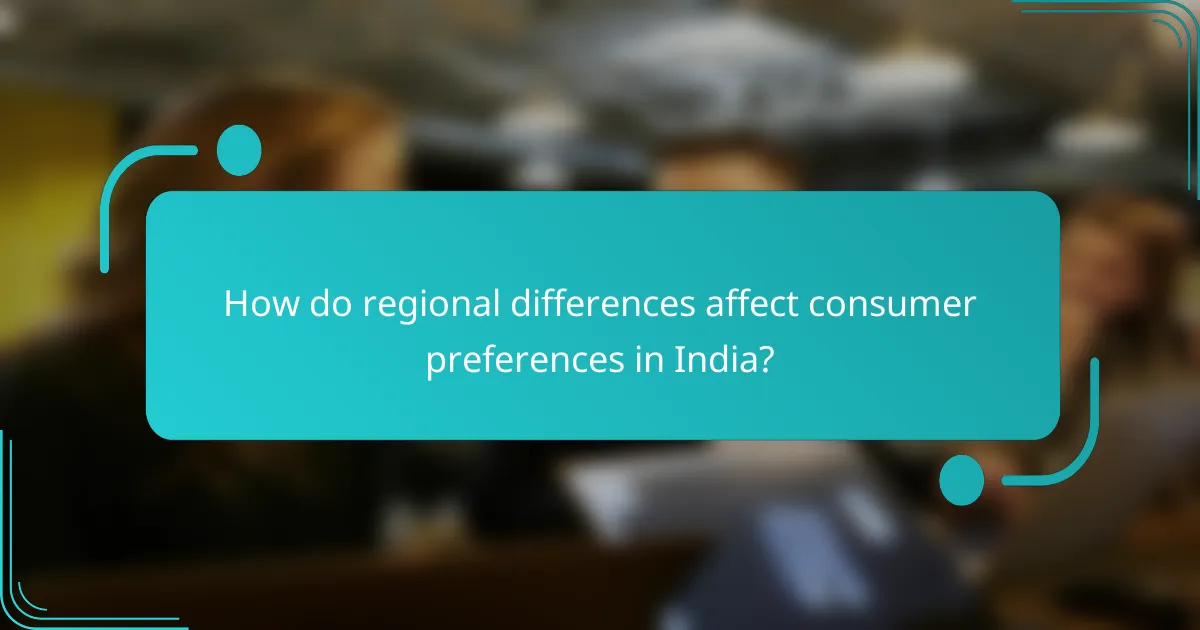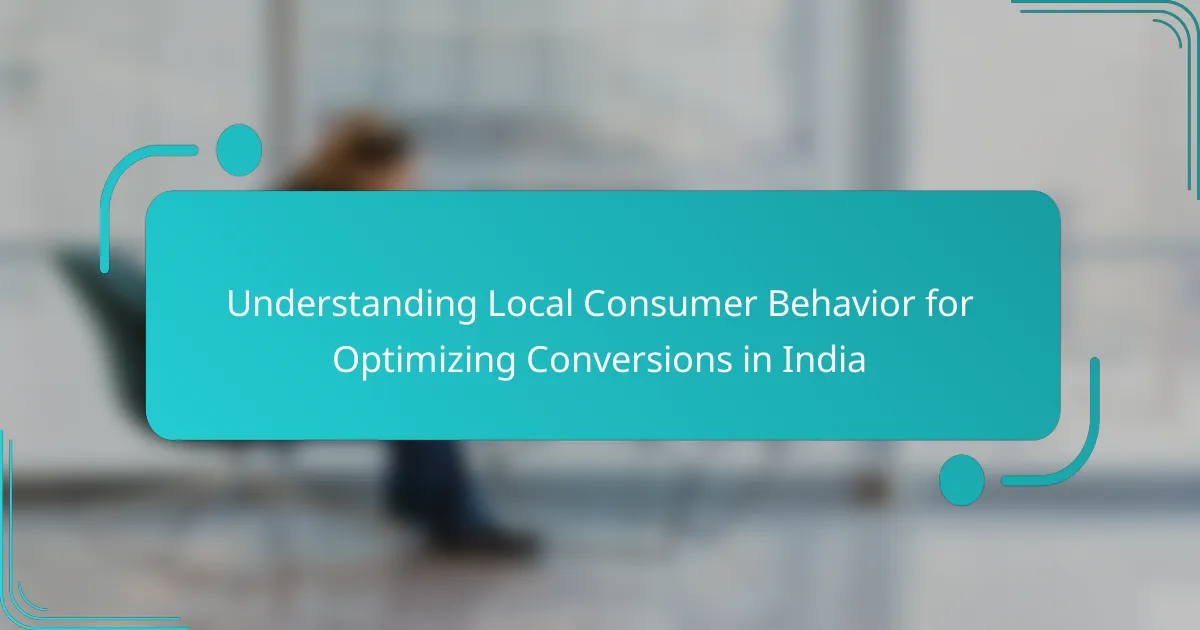Understanding local consumer behavior in India is essential for businesses looking to optimize conversions by aligning their marketing strategies with the unique preferences and habits of Indian consumers. By examining cultural nuances, economic conditions, and regional trends, companies can effectively tailor their approaches to meet the diverse needs of this vibrant market.

How can understanding local consumer behavior increase conversions in India?
Understanding local consumer behavior in India can significantly boost conversions by aligning marketing efforts with the preferences and habits of the target audience. By analyzing cultural nuances, purchasing patterns, and regional trends, businesses can tailor their strategies to meet the specific needs of Indian consumers.
Targeted marketing strategies
Targeted marketing strategies involve segmenting the consumer base and crafting messages that resonate with specific groups. In India, this can mean focusing on regional languages, cultural festivals, or local events that influence buying decisions. For example, promoting products during Diwali with culturally relevant advertisements can enhance engagement.
Utilizing data analytics to identify consumer segments based on demographics, interests, and online behavior can lead to more effective campaigns. Businesses should consider using platforms like Facebook and Google Ads to create targeted ads that reach specific audiences in various regions.
Personalized customer experiences
Creating personalized customer experiences is essential for increasing conversions. This can be achieved through tailored recommendations, customized emails, and loyalty programs that reflect individual preferences. For instance, an e-commerce site can suggest products based on previous purchases or browsing history, making the shopping experience more relevant.
Additionally, implementing chatbots that communicate in local languages can enhance customer service and engagement. Personalization not only improves user satisfaction but also fosters brand loyalty, encouraging repeat purchases.
Localized content creation
Localized content creation involves developing marketing materials that reflect the cultural and linguistic diversity of India. This includes translating content into regional languages and adapting visuals and messaging to align with local customs and values. For example, a campaign featuring local celebrities can resonate more with consumers than generic international figures.
Moreover, businesses should consider creating region-specific content that addresses local issues or interests. This could involve blog posts, social media updates, or videos that highlight local traditions or festivals, ensuring that the content feels relevant and engaging to the target audience.

What are the key factors influencing consumer behavior in India?
Key factors influencing consumer behavior in India include cultural values, economic conditions, and digital literacy levels. Understanding these elements is crucial for businesses aiming to optimize conversions in this diverse market.
Cultural values and traditions
Cultural values and traditions play a significant role in shaping consumer behavior in India. For instance, festivals like Diwali and Eid drive substantial spending as consumers prioritize purchases related to celebrations and gifting.
Moreover, family-oriented decision-making is common, where purchases are often influenced by family members. Brands that align their messaging with cultural narratives tend to resonate better with Indian consumers.
Economic conditions
The economic conditions in India, including income levels and employment rates, directly impact consumer spending habits. With a growing middle class, there is an increasing demand for affordable luxury goods and services.
Price sensitivity remains high, especially among lower-income groups. Businesses should consider offering a range of products at different price points to cater to diverse economic segments.
Digital literacy levels
Digital literacy levels vary widely across India, influencing how consumers engage with online shopping. Urban areas typically show higher digital literacy, leading to increased e-commerce participation compared to rural regions.
To optimize conversions, businesses should ensure their online platforms are user-friendly and accessible, providing support for less tech-savvy consumers. Offering local language options can also enhance engagement and trust among diverse user groups.

How do regional differences affect consumer preferences in India?
Regional differences significantly shape consumer preferences in India, influencing purchasing decisions, brand loyalty, and product choices. Understanding these variations is crucial for businesses aiming to optimize conversions across diverse markets.
Urban vs. rural consumer behavior
Urban consumers in India tend to prioritize convenience, brand reputation, and quality, often influenced by global trends and digital marketing. In contrast, rural consumers may focus more on value for money, local brands, and practical utility, reflecting their different lifestyles and purchasing power.
For example, urban shoppers might prefer online shopping platforms for their variety and ease, while rural consumers often rely on local markets and traditional retail for their everyday needs. Businesses should tailor their marketing strategies to address these distinct behaviors effectively.
Language and communication styles
India’s linguistic diversity means that language plays a critical role in consumer engagement. Urban areas may favor English or Hindi, whereas rural regions often prefer local dialects, making it essential for brands to adapt their messaging accordingly.
Using regional languages in advertising can enhance relatability and trust among consumers. Brands should consider employing local influencers or community leaders to communicate effectively and resonate with their target audience.
Local festivals and shopping habits
Festivals in India, such as Diwali and Holi, significantly influence shopping behavior, with many consumers planning their purchases around these events. During festivals, there is often a surge in demand for gifts, clothing, and home decor, creating opportunities for targeted promotions.
Businesses can capitalize on these occasions by offering special discounts, festive bundles, or limited-time products. Understanding local customs and shopping patterns during these times can lead to increased sales and customer loyalty.

What tools can be used to analyze consumer behavior in India?
To effectively analyze consumer behavior in India, businesses can leverage various tools that provide insights into user interactions and preferences. These tools help identify trends, optimize marketing strategies, and enhance customer engagement.
Google Analytics
Google Analytics is a powerful tool for tracking website traffic and user behavior. It allows businesses to monitor metrics such as page views, bounce rates, and user demographics, which are crucial for understanding consumer preferences in India.
To maximize its effectiveness, set up goals and conversion tracking tailored to your business objectives. Regularly review the data to identify patterns and adjust your marketing strategies accordingly.
Social media insights
Social media platforms like Facebook, Instagram, and Twitter offer built-in analytics that provide valuable insights into consumer behavior. These insights include engagement rates, audience demographics, and content performance, helping businesses tailor their messaging to resonate with Indian consumers.
Utilize these insights to refine your content strategy and target specific audience segments. Regularly analyze which posts perform best to enhance engagement and drive conversions.
Survey platforms like SurveyMonkey
Survey platforms such as SurveyMonkey enable businesses to gather direct feedback from consumers. This tool is particularly useful for understanding preferences, satisfaction levels, and purchasing motivations among Indian customers.
Design surveys that are concise and relevant to your target audience. Consider offering incentives for participation to increase response rates and ensure you gather actionable insights that can inform your marketing strategies.

What are the best practices for optimizing conversions based on consumer insights?
To optimize conversions in India, businesses should leverage local consumer insights through targeted strategies. Understanding cultural preferences, shopping behaviors, and feedback can significantly enhance marketing effectiveness and drive sales.
A/B testing for localized campaigns
A/B testing is crucial for determining which localized campaigns resonate best with Indian consumers. By comparing two versions of a campaign—such as different headlines or images—businesses can identify what drives higher engagement and conversions.
Focus on aspects like language, visuals, and offers that reflect local tastes. For example, testing a campaign featuring regional festivals can yield insights into seasonal buying patterns. Aim for a sample size that provides statistically significant results, typically in the low hundreds or thousands.
Utilizing customer feedback
Gathering and analyzing customer feedback is essential for understanding consumer preferences in India. Surveys, reviews, and social media interactions can provide valuable insights into what customers value most.
Encourage feedback through incentives, such as discounts or loyalty points, to increase participation. Regularly review this feedback to adapt your offerings and marketing strategies, ensuring they align with evolving consumer expectations.
Implementing user-friendly website designs
A user-friendly website design is vital for optimizing conversions, especially in a diverse market like India. Ensure that your site is easy to navigate, loads quickly, and is mobile-responsive, as a significant portion of online shopping occurs via smartphones.
Consider incorporating local languages and payment options, such as UPI or cash on delivery, to enhance accessibility. Regularly test your website’s usability with real users to identify pain points and improve the overall shopping experience.

How can affiliate marketing leverage local consumer behavior in India?
Affiliate marketing in India can effectively leverage local consumer behavior by understanding regional preferences, cultural nuances, and shopping habits. By tailoring marketing strategies to resonate with local audiences, businesses can significantly enhance conversion rates.
Understanding Regional Preferences
India is a diverse country with varying preferences across its regions. For instance, consumers in urban areas may prefer online shopping due to convenience, while those in rural areas might favor traditional retail. Recognizing these differences allows affiliate marketers to customize their approaches, such as promoting online deals in cities and highlighting local stores in rural campaigns.
Additionally, seasonal trends and festivals play a crucial role in consumer behavior. Marketers should align their promotions with local festivals like Diwali or Eid, when spending typically increases, to capture consumer interest effectively.
Cultural Nuances and Language
Understanding cultural nuances is vital for successful affiliate marketing in India. Language plays a significant role; using local languages in advertisements can create a stronger connection with consumers. For example, campaigns in Hindi or regional languages can enhance relatability and trust.
Moreover, cultural values influence purchasing decisions. Emphasizing family-oriented products or services can resonate well with Indian consumers, who often prioritize family needs in their buying choices.
Shopping Habits and Online Behavior
Indian consumers exhibit unique shopping habits, such as a preference for mobile shopping. With a significant portion of the population using smartphones, optimizing affiliate marketing for mobile platforms is essential. This includes ensuring that websites are mobile-friendly and that promotions are easily accessible on mobile devices.
Additionally, many consumers conduct extensive research before making purchases. Affiliate marketers should focus on providing valuable content, such as reviews and comparisons, to assist consumers in their decision-making process. This approach not only builds trust but also encourages conversions.
